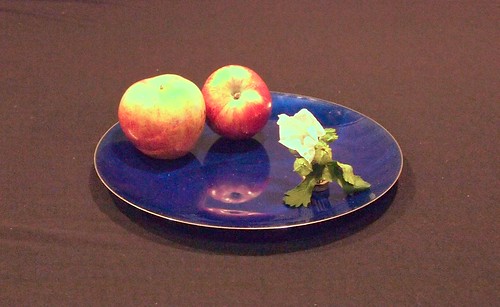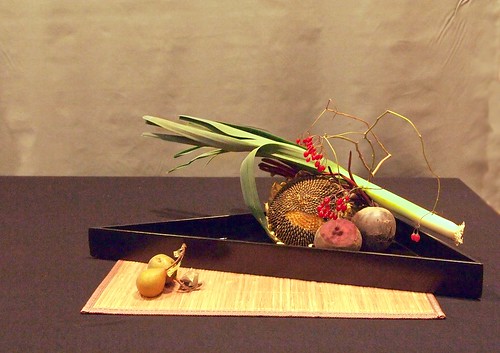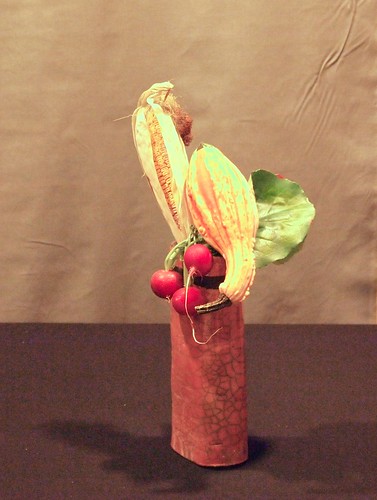Morimono, harvest festival style.
Leek, beetroots, mini pears, Sun flower, bittersweet.
Leek, beetroots, mini pears, Sun flower, bittersweet.
Last week I was invited to give a demonstration of morimono at the Ikebana International Oslo Chapter. Morimono is basic style ikebana arrangements made with fruit and/or vegetables as the main material. It is often combined with a small amount of other materials, such as flowers, roots and branches. The idea is not to create a delicious fruit plate, but an ikebana arrangement where shape, color and lines are important.
Morimono has its roots in fruit offerings at harvest festivals, and in food offerings in front of Buddha sculptures and pictures of deceased relatives. There are several festivals related to good harvest. "Labor Thanksgiving Day", November 23rd., is a national holiday when the emperor performs food offerings on behalf of the people. Also the Shinto festivals at New Years, and tsukimi "moon viewing" in September, are linked to hope of good harvest.

Morimono, minimalist "platter design" Sogetsu 1960s style.
Apples and Malva flower.

Morimono with the shin element enhanced by a leaf.
Gourds, rose hip and hosta leaf.
Morimono has its roots in fruit offerings at harvest festivals, and in food offerings in front of Buddha sculptures and pictures of deceased relatives. There are several festivals related to good harvest. "Labor Thanksgiving Day", November 23rd., is a national holiday when the emperor performs food offerings on behalf of the people. Also the Shinto festivals at New Years, and tsukimi "moon viewing" in September, are linked to hope of good harvest.

Morimono, minimalist "platter design" Sogetsu 1960s style.
Apples and Malva flower.
In the Sogetsu School, morimono, along with uki-bana (fleeting arrangement) and shiki-bana (arrangement placed directly on a table or a surface without dai or container) belongs to variation no. 7. The three styles in this group have in common that the composition is about arranging positions and combinations of materials to bring out their unique qualities.
The name morimono is a compound word that comes from moru "to heap up" and mono "thing", it's literally translated to "heaped up things" (cf. moribana "heaped up flowers" - morimono is an extension of moribana). The style ranges from simplicity and melancholy of fall with a sense of wabi-sabi, to the joy and abundance of harvest. Morimono can also be made with figures or other things, stone, leaves, roots, etc.

Morimono with the shin element enhanced by a leaf.
Gourds, rose hip and hosta leaf.
Although morimono is a basic style arrangement it doesn't always make sense to start with the correct length of the materials. Instead one must translate the main branches, shin, soe and hikae, to form and volume. You arrange the materials so that the arrangement is recognizable as a basic style or one of the variations of them.
Morimono is usually arranged on a dai. It can be anything that fits, such as a board, a plate, a straw mat, a low basket or a large leaf. The color of dai is important. It often works nice when the dai reinforces colours from the materials either by matching them or by contrasting. Morimono can also be arranged as nageire in a tall vase.
Morimono is usually arranged on a dai. It can be anything that fits, such as a board, a plate, a straw mat, a low basket or a large leaf. The color of dai is important. It often works nice when the dai reinforces colours from the materials either by matching them or by contrasting. Morimono can also be arranged as nageire in a tall vase.
Morimono, nageire.
Mais, gourd, raddishes, Bergenia leaves.
Mais, gourd, raddishes, Bergenia leaves.
Freestyle moribana. Straight and curved lines.
Parsley roots, Dahlia.
Parsley roots, Dahlia.
As with all the basic styles, there is also a free style extension of morimono. In the free style the focus is on creating a more playful sculptural arrangement.
Freestyle nageire. Curved lines.
Chives, red cabbage, mini pear, Creepers, bleached hemp.
Chives, red cabbage, mini pear, Creepers, bleached hemp.
(Sorry about the bad photo quality in this blog post. I recognized too late that the camera settings where incorrect.)
















4 comments:
Dear Lennart,
your variety of examples and written explanations of morimono are excellent. I love the sculptural qualities of the work and the warmth of the colour palate.
Best wishes, Christopher
Congratulations on your demonstration! They are all unique and beautiful. I love them all!
Dear Christopher.
Thank you for your kind and encouraging words. I too like the colours of this season. The trees in the Botanical garden outside my window are shifting to all shades of yellow, orange and red to go with the green.
Lennart
Stephen - thanks for commenting. I'm glad you like them. I'm not that used to demonstrate yet, but I like it, and I feel that I learn a lot from it every time.
Post a Comment